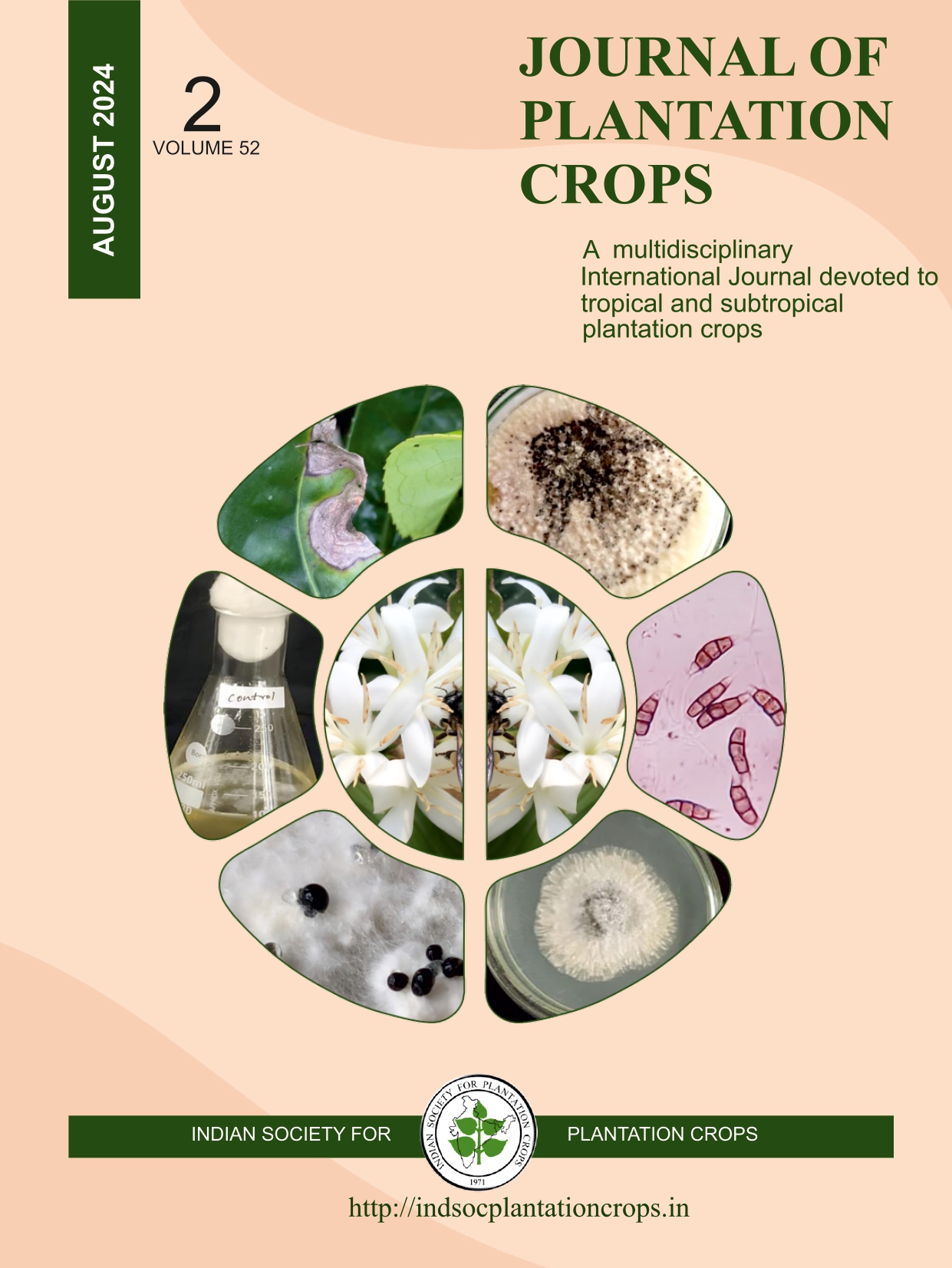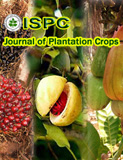From coast to Isle: exploring the morphological diversity of tender coconuts in selected Indian accessions
DOI:
https://doi.org/10.25081/jpc.2024.v52.i2.9621Abstract
Coconut (Cocos nucifera L.) is an economically and nutritionally important tropical crop, particularly renowned for its oil and tender coconut water, a beverage known for its hydrating properties and health benefits. This study investigates the morphological diversity of tender nuts from various coconut accessions collected from coastal and island ecosystems in India. A total of 31 coconut accessions, including the Indian West Coast Tall (WCT) as a reference, were evaluated for tender nut traits. Significant variability was observed, with tender coconut weights ranging from 831.67 g in Andaman Horned Tall to 2940.83 g in Kodiaghat Brown Tall. Quantity of tender coconut watervaried from 85.55 mL in Andaman Horned Tall to 545.58 mL in Kodiaghat Brown Tall followed byDugong Creek Tall (495.83 mL) and Nicobar Tall AuckChung (485.0 mL). The average TSS was 5.0° Brix, with Andaman Horned Tall recording the highest TSS at 5.98° Brix. Accessions such as Kodiaghat Brown Tall and Dugong Creek Tall demonstrated superior traits, suggesting their potential in varietal breeding programs. The study underscores the genetic diversity present in coconut accessions, with implications for improving tender coconut production. The findings highlight the importance of understanding these traits for developing varieties that meet consumer and market demands, ultimately contributing to the sustainability of coconut.
Downloads
References
Apshara, S. E., Arunachalam, V., Jayabose, C. and Kumaran, P. M. 2007. Evaluation of coconut hybrids for tender nut purpose. Indian J. Hort., 64(3):320-323.
Chikkasubbanna, V., Jayaprasad, K. V., Subiah T. and Pooncha, N. M. 1990. Effect of maturity on the chemical composition of tender coconut (Cocos nucifera L. var. Arsikere Tall) water. Indian Coconut J., 20:10-15.
Devakumar, K. Jerard, B. A. Dhanapal, R., Damodaran, V. Niral, V. and Naganeeswaran, S. 2010. Genetic relatedness of coconut populations from Andaman and Nicobar Islands traced to the Indian sub-continent using microsatellite markers. pp. 67–75. In: International Conference on Coconut Biodiversity for Prosperity. (Eds). Thomas, G.V., Krishnakumar, V., Augustine Jerard, B.A., Central Plantation Crops Research Institute, Kasaragod, Kerala, India.
Hernández, R., Pérez, A. M. and Ruiz, J. L. 2018. Nutritional and functional properties of coconut water. Journal of Nutritional Science, 7. e24.
Jackson, M.L. 1973. Soil Chemical Analysis. Prentice Hall, New Delhi. 478 p.
Jangam, A. K. and Thali, P. 2004. WASP-Web Agri Stat Package 2.0. ICAR Research Complex for Goa, Ela, Old Goa, Goa. 403 402. India.
Kanimozhi, K., Thangavel, M. K. and Vennila, P. R. 2018. Factors influencing the quality of tender coconut water. Indian J of Hort., 75(1):45-50.
Kanimozhi, T., Shoba, N. and Venkatesan, K. 2018. Evaluation of Coconut Hybrids for Tender nut. Madras Agric. J., 105(7-9): 329-331.
Karun, A. and Niral, V., 2019, Coconut Genetic Resources. In: Rajasekharan, P., Rao, V. (eds) Conservation and Utilization of Horticultural Genetic Resources. Springer, Singapore.
Niral, V. and Ranjini, T. N. 2018. Tender coconut varieties. Indian Coconut Journal, p.4.
Niral, V., Jerad, B. A., Jayasekhar, S. and Chowdappa, P. 2019. Tender coconuts for nutritional security. Indian Horticulture, 59(6).
Niral, V., Jerard, B.A. and Rajesh, M. K. 2021. Germplasm resources: diversity and conservation. The Coconut Genome, pp 27-46.
O’Brien, B. J., Bell, L. R., Hennessy, D., Denham, J. and Paton, C. D. 2023. Coconut Water: A Sports Drink Alternative? Sports, 11(9):183.
Panse, V. G. and Sukhatme, P. V. 1961. Statistical methods for agricultural workers. ICAR, New Delhi. pp381.
Poduval, M., Abu Hasan, M. and Chattopadhyay, S. K. 1998. Evaluation of coconut cultivars for tender nut water for West Bengal. Indian Coconut J.,29:3-6.
Prades, A., Dornier, M., Diop, N. and Pain, J. P. 2012. Coconut water uses, composition and properties: a review, Fruits, 67:87-107.
Pue, A. G., Riva, W., Sundarao, K., Kaluarin, C. and Singh, K. 1992. Preliminary Studies on Changes in the Coconut Water during Maturation of the Fruit. Science in New Guinea, 18(2):81-84.
Ranasinghe, S., Weerakoon, D. P. and Perera, M. S. 2015. Morphological traits of coconut and their implications for breeding. Journal of Crop Science, 55(4):345-352.
Ratnambal, M. J., Nair, M. K., Muralidharan, K., Kumaran, P. M., Bhaskara Rao, E. V. V. and Pillai, R. V. 1995. Coconut descriptors Part 1. Kasaragod: C.P.C.R.I.
Ratnamabal, M. J., Niral, V., Krishnan, M. and Ravi Kumar, N. 2000. Coconut descriptors, Part II. Kasaragod: CD-ROM, C.P.C.R.I.
Ratnambal, M. J. 1999. Varieties suitable for tender coconut. Indian Coconut J., 30(5):64-67.
Rethinam, P. and Nandakumar, T. B. 2001. Tender coconut – An overview. Indian Coconut J., 32(1):2-22.
Royal Horticultural Society colour chart. 2001. Royal Horticultural Society British Colour Council London, UK.
Sankaran, M., Damodaran, V., Singh, D. R., Jai Sankar, I. and Jerard, B. A. 2012. Characterization and diversity assessment in coconut collections of Pacific Ocean Islands and Nicobar Islands. African J. of Biotech., 11(97):16320-16329.
Published
How to Cite
Issue
Section
Copyright (c) 2025 Journal of Plantation Crops

This work is licensed under a Creative Commons Attribution 4.0 International License.








 .
.